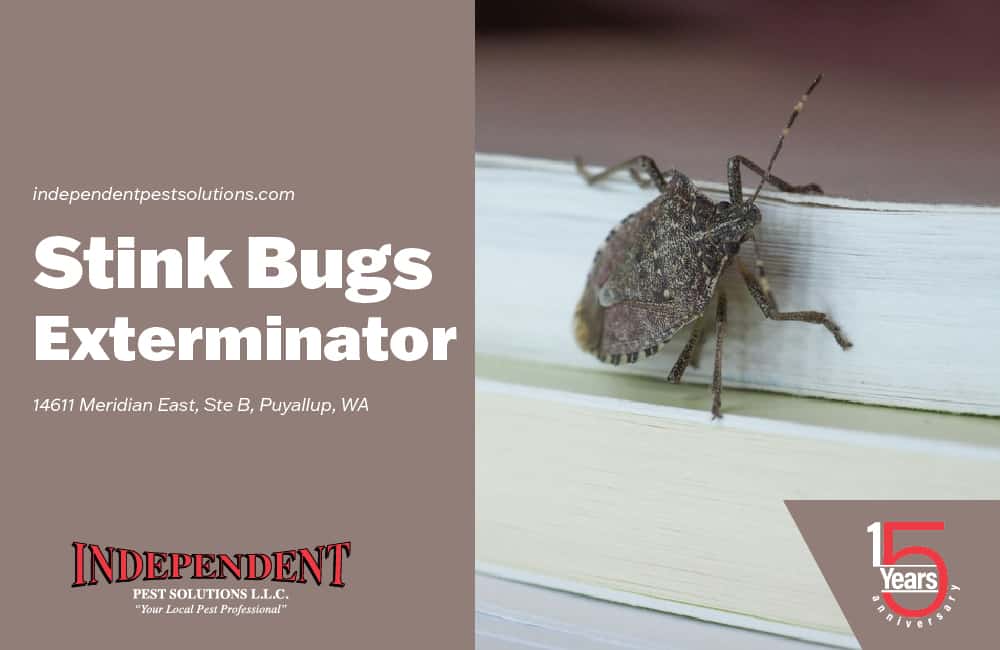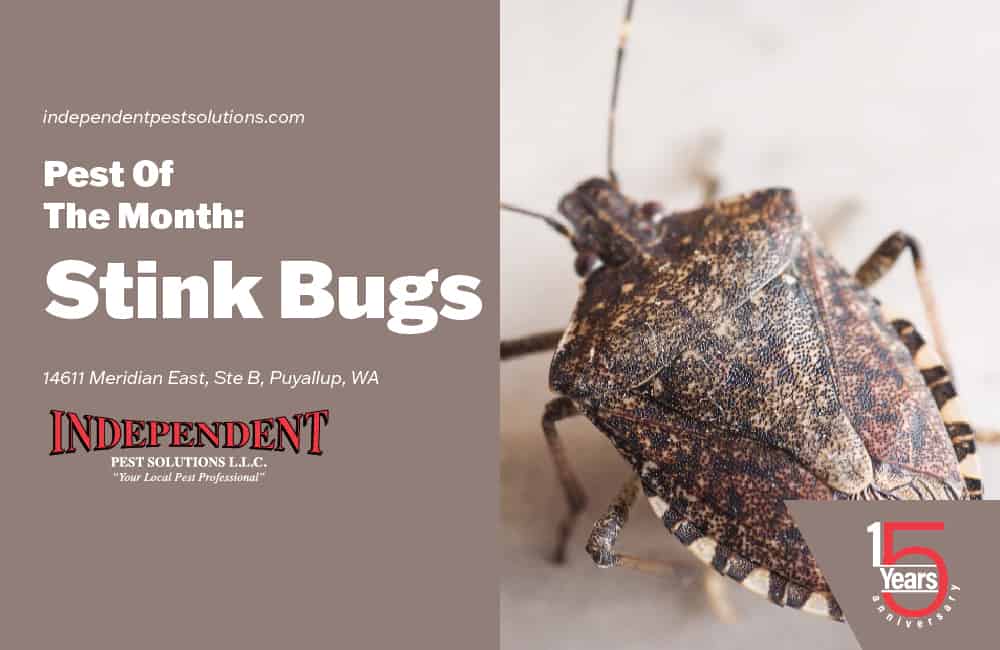Stink Bug Exterminator
As the weather gets colder, you may begin to notice strange, large bugs begin to appear in your home. These are called stink bugs, and specifically brown marmorated stink bugs are common in Washington state. They can be recognized due to their shield-shaped carapace and their streaked or marbled patterning. Their bodies are flat and wide, which is helpful for sneaking through cracks into homes.
You may be surprised that stink bugs are actually not native to the Pacific Northwest region. They are native to China, Japan, Korea, and Taiwan. They likely initially got from Asia to North America in shipping containers, and the first specimen in North America was collected in the late 90s. These invasive pests have caused the most damage in the mid-Atlantic region but are now distributed in almost every state. Some states haven’t reported having to deal with stink bugs. In Washington state, stink bugs are known to live in at least 29 different counties. However, their population levels are not as severe as in the East Coast and Oregon.
Stink bugs are known for having a voracious appetite and have caused severe issues for agriculture. Their mouths are adapted for piercing and sucking. These bugs are not picky- they feast upon a wide variety of plant life. They eat fruits such as apples, peaches, pears, apricots, cherries, tomatoes, grapes, and more. They also enjoy vegetables such as lima beans, peppers, corn, and soybeans. When they target orchards and crops, infestations can wipe out the produce. They can cause bruises, and blemishes, leave necrotic patches on plant material, and even change the levels of sugar in fruits. Stink bugs don’t just eat things that humans do; they also eat ornamental and landscaping plants.
As days get shorter and temperatures begin to drop, stink bugs begin to seek out shelter for hibernation. You may be displeased to learn that your business or home is the perfect place for stink bugs to set up their winter camps. They don’t want to be out in the cold; they want to be somewhere warm and cozy. This period in the stink bug life cycle is called diapause. During this time, they are inactive. They don’t eat or reproduce- females cannot reproduce until it gets warmer again. Once stink bugs find a suitable location for overwintering, they release a pheromone that attracts other stink bugs to their location so they can aggregate.
You may be surprised to find stink bugs in your home, thinking there’s no way they could get in. However, these pests are adept at sneaking into buildings. They get into man-made structures through gaps and holes in foundations, door and window frames, crevices, cracks, attics, beneath siding, and more. You are especially likely to encounter indoor stink bug infestations if your home or other building is located next to a place where stink bugs like to live. Examples could be a fruit orchard, a big garden, an agricultural field, or a place with many trees and ornamental shrubs.

Stink Bugs Pest Control
The best defense against having to share your home with stink bugs is to try and keep them from getting in in the first place (exclusion methods). Stripping, caulking, tape, smart practices, and more can make your home fortified against stink bugs and other pests. You should seal up crevices and gaps around door and window frames and foundations, as well as anywhere that there are holes for wiring and piping to go through. Stink bugs can crawl through tiny openings because they are so small. If you install tight-fitting screens with no holes and dense mesh, stink bugs are less likely to be able to get in through your roof vents. If you have a fireplace, you should close the flu when you are not using it. An open flu is just inviting pests to come into your warm home.
If individual stink bugs do make it inside, you should remove them gently. You can pick them up with a tissue or paper towel and throw them away outside or vacuum them up. However, vacuuming them should be a last resort option, because it can trigger the stink bugs to release the stench that they were named for. This can make your vacuum smell disgusting. There are handheld special vacuums designed specifically for sucking up stink bugs, however. You could also sweep the stink bugs into a bucket and then fill it up with enough soapy water to submerge them. If you throw away the bugs, the trash bag should be not kept in the house.
For stink bug infestations, you should reach out to our pest control service near you. Independent Pest Solutions can help get rid of stink bugs and keep them from coming back. Our pest control methods are both safe and effective and pose no harm to people or pets in the home. Washington state officials have recommendations for catching stink bugs. Pheromone and light traps should be utilized instead of pesticides because pesticides could have collateral damage and kill helpful bugs such as ladybugs.
The other option, aside from pest control, is to just tolerate the presence of the stink bugs. Their mouths are designed for piercing plants and sucking out their juices but aren’t really useful for biting people. Stink bugs tuck these mouth parts between their legs when they aren’t using them, and stink bugs are not capable of stinging humans. Unless you do something to seriously disturb them (which can trigger them to release their odor), the stink bugs aren’t going to do anything. When stink bugs are inside of a home for the winter, they are in a dormant phase. They’re not going to eat anything, reproduce, or lay eggs in your house, meaning your furniture and food storage is safe. However, if left alone in the spring, the stink bugs will crawl back outside and start attacking your garden again.
It’s easiest to eliminate stink bugs when they are hibernating, as opposed to trying to find them while they’re hiding amongst your plants. If you are tired of dealing with invasive stink bugs, reach out to Independent Pest Solutions. Our expert pest control technicians can save you all over the pacific northwest from stress, frustration, and wasting money and time. If you are having stink bug issues, reach out to us so that we can perform an initial inspection. We provide proven methods for getting rid of stink bugs.

Committed
to Cleaning and
Excellence
Hassle-free
Leave us a Message
Contact Independent Pest Solutions
Get In Touch
Call toll-free
In Puyallup call
14611 Meridian East
Ste B Puyallup, WA 98374


